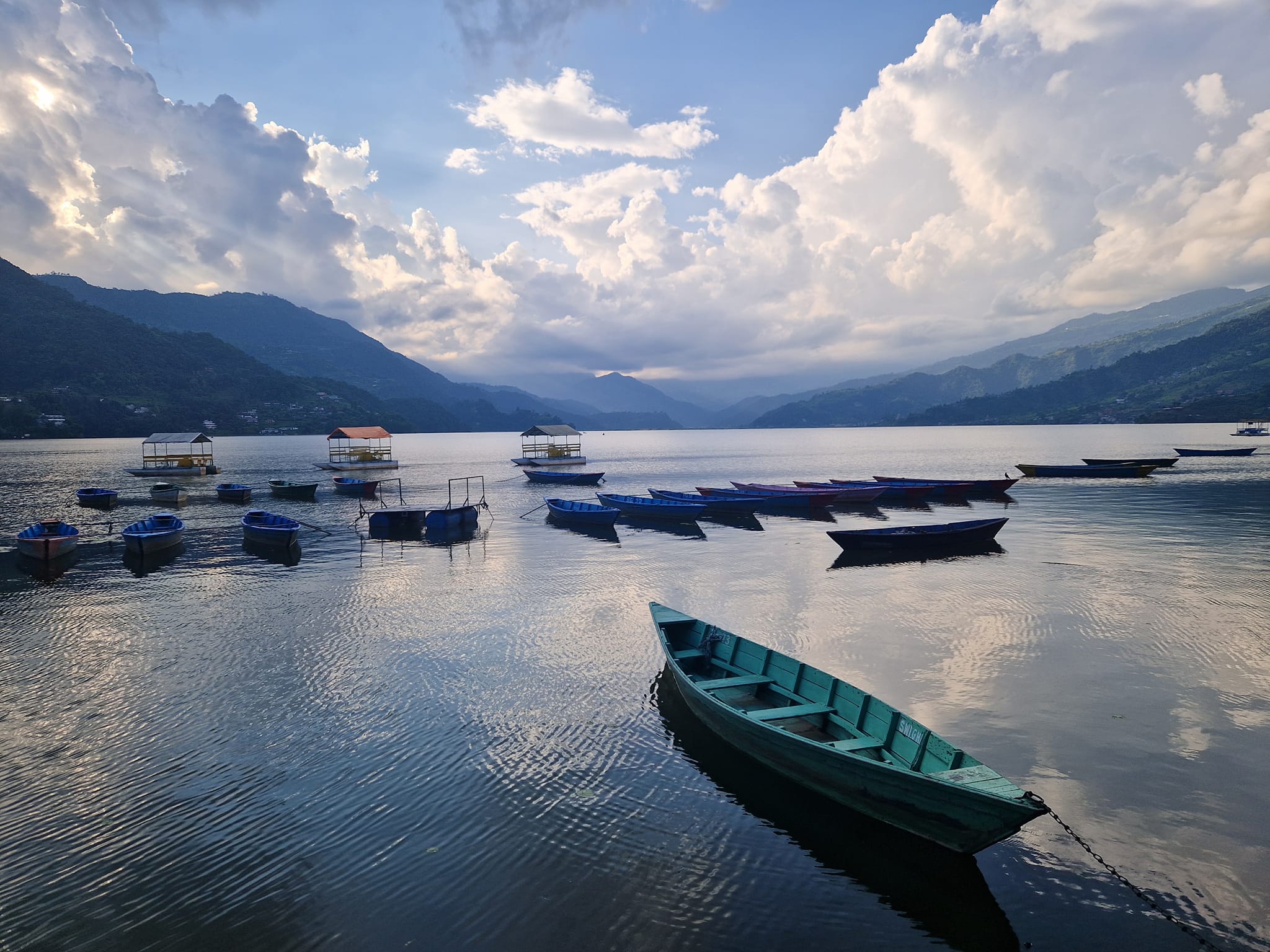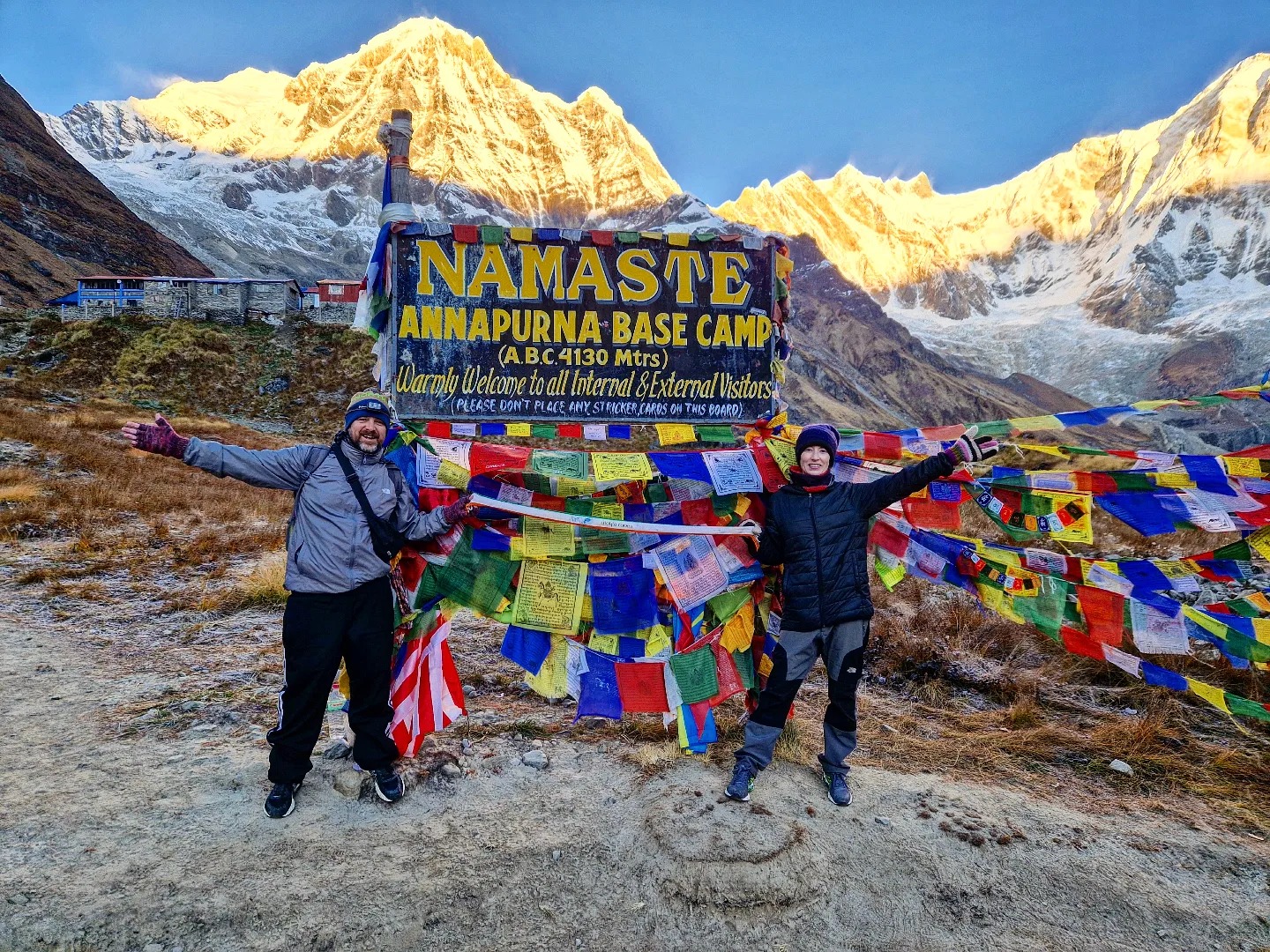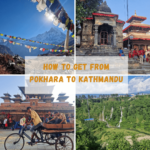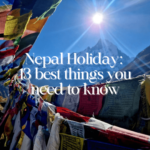Nepal, the land of majestic mountains, ancient temples, and vibrant cultures, attracts travelers year-round. However, understanding the best time to visit Nepal is essential, whether you’re trekking in the Himalayas, exploring UNESCO World Heritage Sites, or immersing yourself in the local traditions.
We traveled to Nepal in early October and even though technically the monsoon season is over by September, we saw the lashing rains almost six weeks later. As in many parts of the world these days, there was a much later-than-usual monsoon, which resulted in many devastating landslides across Nepal
Given these factors, this Nepal weather guide is essential reading before your trip. It will help ensure your safety and help you make the most of your visit to this extraordinary country.
We will offer detailed insights into the best times to visit Nepal to help you best plan your trip. This Nepal weather guide will highlight the advantages of each season based on particular activities and festivals, while also addressing any potential downsides.
Rest assured we got you covered and plan to answer any Nepal weather questions you have, leaving no stone unturned.
Let’s get straight into it so you can start planning your Nepal trip.
Nepal Weather: Understanding Nepal’s Seasons
Nepal weather is diverse, with conditions varying significantly based on altitude. The country has four distinct seasons: spring, summer (monsoon), autumn, and winter.
Each season offers unique experiences, and the ideal time to visit depends on the activities you’re interested in, whether it’s trekking, sightseeing, or cultural exploration.
Autumn (September to November): The Peak Trekking Season
Why It’s the Best Time: Autumn is considered the best time to visit Nepal, especially for trekking enthusiasts. The weather is mild, clear, and dry, offering ideal conditions for outdoor activities. The post-monsoon skies are crystal clear, providing stunning views of the Himalayan peaks, including Everest, Annapurna, and Langtang.
Weather: The monsoon rains have subsided by late September, leaving the air fresh and the landscapes lush. Daytime temperatures are comfortable, ranging from 10°C to 25°C (50°F to 77°F) in Kathmandu, with cooler temperatures in the mountains.
Activities: This is the perfect season for trekking popular routes like the Everest Base Camp Trek and the Annapurna Range. Trust us you will want to be able to see those majestic Himalayan mountain peaks after hiking for 3 days getting there! It’s also an excellent time for cultural exploration in cities like Kathmandu, Bhaktapur, and Pokhara.
Festivals: Autumn coincides with Nepal’s biggest and most important festival, Dashain, which celebrates the victory of good over evil. The festive atmosphere in Nepal during this period is vibrant and adds a cultural richness to your visit. Trust us (again!) this is not something to be missed and we felt extremely honored to be in Nepal during this time, witnessing the love and connection as families come together to celebrate.
Drawbacks: As this is the peak tourist season, trekking routes and popular destinations like Kathmandu and Pokhara can get very crowded and booked up – not to mention the higher prices during peak season. Early booking of accommodations and permits is highly recommended.
Before you head off on your Nepal Holiday, make sure to check out our top 13 things to know before you visit.
Spring (March to May): Ideal for Trekking and Nature Lovers
Why It’s a Great Time: Spring is another excellent time to visit Nepal, especially for those who want to experience the beauty of nature in full bloom. The temperatures are warm, the days are long, and the skies are generally clear. Spring also brings vibrant wildflower blooms, particularly rhododendrons, which transform the landscape into a colorful haven. Sounds pretty amazing right?!
Weather: Spring weather is moderate, with daytime temperatures ranging from 15°C to 30°C (59°F to 86°F) in Kathmandu and, of course, cooler temperatures in the mountains. The higher altitudes may still have some snow, but the weather conditions are generally good for trekking.
Activities: Like autumn, spring is a great time for trekking, especially on routes like the Annapurna Base Camp Trek and the Langtang Trek. The trails are less crowded than in autumn, but you still get excellent visibility and comfortable temperatures. Spring is also ideal for cultural tours and wildlife safaris in the Chitwan National Park.
If you plan on taking on the Annapurna Base Camp trek, you can see exactly how we got on during our 6-day Annapurna hike Vlog.
Festivals: The Holi Festival, falls in March. If you’re lucky enough to be in Kathmandu or Pokhara during this time, you can enjoy the color-filled festivities and experience a unique cultural tradition like no other. After experiencing Dashain, we plan to return to Nepal during this festival on our next visit.
Drawbacks: Although spring is slightly less crowded than autumn, it’s still a popular time for trekkers. Certain trekking routes can become busy, so booking accommodations in advance is still recommended.
We found that Trip.com offered the best deals on accommodation, be sure to check that out when planning your Nepal holiday.
Summer/Monsoon (June to August): Off-Peak Travel Time
Why It’s Less Popular: The summer months in Nepal coincide with the monsoon season, which brings heavy rainfall, especially from June to August. While it’s not the best time for trekking, it can still be an ideal season for travelers looking to explore Nepal’s lower-altitude regions, cultural sites, and remote areas less affected by the rain.
Weather: Expect hot and humid conditions in the lowland areas, with daytime temperatures ranging from 25°C to 35°C (77°F to 95°F). The monsoon rains can make high-altitude trekking routes dangerous due to slippery trails, landslides, and poor visibility.
Activities: Monsoon is not ideal for trekking in the popular regions of Nepal like Everest, Annapurna, or Langtang. However, Chitwan National Park offers good wildlife viewing opportunities, as rain makes the jungles more vibrant and wildlife more active.
Festivals: Teej, a major Hindu festival celebrated by women, usually takes place in the monsoon season. It offers a unique cultural insight into Nepalese traditions and rituals, especially if you’re in Kathmandu during the festivities.
Drawbacks: Trekking in the Himalayas can be challenging and risky due to the rain and muddy conditions. Many trekking routes are less accessible due to landslides and trail damage. Even if you’re planning to travel within Nepal during the monsoon season, be aware that landslides can block roads and halt travel altogether. In addition to the disruptions, there are the casualties from said landslides. So, it’s important to ask yourself: is the risk worth it?
No visit to Nepal is complete without witnessing the highest mountain on Earth – Mount Everest. Use the link below to find out more!
Winter (December to February): For Adventure Seekers and Low-Key Exploration
Why It’s a Good Time: While winter in Nepal may not be the most popular time for trekking in the high mountains, it offers a completely different experience. This Nepal weather is dry and sunny, and the crowds are significantly reduced, making it a great time for a more peaceful and quiet experience in the mountains or the cities.
Weather: Winter temperatures can drop drastically, particularly in the mountain regions. Kathmandu sees daytime temperatures of 10°C to 20°C (50°F to 68°F), while in the mountains, temperatures can plummet well below freezing. The higher the altitude, the colder it gets, and trekking to Everest Base Camp or other high-altitude treks during this time, as you can imagine, requires careful preparation.
Activities: For those looking to experience the snow-covered beauty of the Himalayas without the crowds, winter trekking to lower-altitude regions like Ghorepani Poon Hill or Langtang can be quite rewarding. Kathmandu and Pokhara are also quieter during this time, making it ideal for cultural exploration and sightseeing. Nepal’s lower-altitude national parks, like Chitwan, remain open for wildlife safaris.
Festivals: Lhosar, the New Year festival celebrated by the Tibetan and Sherpa communities, is another notable cultural celebration that takes place during the winter months. If you’re in the Khumbu region during this time, you’ll get a chance to experience this unique celebration in the heart of the Himalayas.
Drawbacks: While winter trekking in Nepal can be magical, it comes with challenges. High-altitude treks are not recommended unless you’re experienced, as temperatures can be extreme and trekking routes may be icy and dangerous. However, for those seeking a quieter experience, winter offers a serene atmosphere without the usual crowds.
Are you getting excited about your Nepal holiday yet? Use the following links and start planning your trip of a lifetime today, what are you waiting for?!
Enjoy Your Visit to Nepal
To sum up an already amazingly detailed Nepal weather article! Here are the main points to take away:
For trekking: The best times to visit Nepal are during autumn (September to November) and spring (March to May). These seasons offer optimal weather, clear skies, and moderate temperatures, making them ideal for the majority of trekking routes.
For cultural exploration: If your primary focus when visiting is cultural discovery, winter (December to February) can be a quiet and serene time to explore cities like Kathmandu, Bhaktapur, and Pokhara, though you should be prepared for cold temperatures.
For wildlife safaris: The monsoon season (June to August) can still be a good time for wildlife enthusiasts to visit Chitwan National Park as the park is lush, and wildlife is more active.
Ultimately, as with any country, the best time to visit Nepal depends on your interests, the activities you want to do, and your tolerance for crowds and weather conditions.
Whether you’re trekking to Everest Base Camp or exploring the cultural heritage of Kathmandu Valley, Nepal offers unforgettable experiences all year round, and we are certain that you will have the most fantastic Nepal holiday no matter when you decide to visit.
In fact, why not let us know how you got on and when you chose to visit Nepal? We would love to hear from you.
Feel free to leave a message below or contact us on our socials.
Slán go fóil


This post contains affiliate links. If you click on the links to make a purchase, we will earn a small commission. This is at NO EXTRA COST to you. This is a free way to support us and allow us to continue to create inspiring adventure travel guides.






